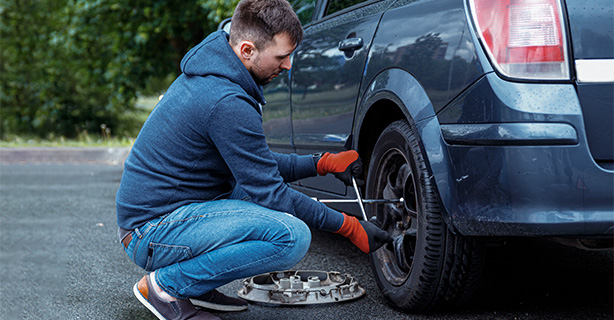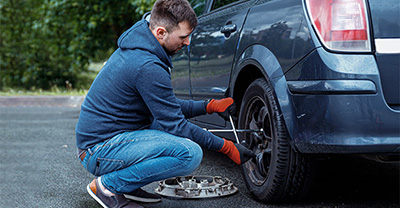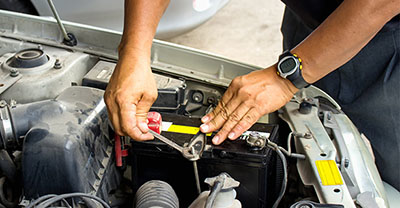14 easy steps to changing a flat tire


0 min. read
Changing a tire is likely easier than you think. By preparing and educating yourself, and following the steps below, you can fix your flat tire and get back on the road in no time.
1. Make sure you have everything you need
Before you hit the road, make sure you have these items stowed in your vehicle so you're ready to change your tire:
Your vehicle's owner manual
Your vehicle's tire kit, which should include a jack, lug nut wrench, and spare tire
Wheel chock blocks or wedges
Flashlight
Tire pressure gauge
2. Find a safe tire-changing location
Whether your tire slowly deflates or pops, the last thing you want to do is abruptly brake or swerve. Drive cautiously and put your hazard lights on until you can find a safe place to pull over. Find a flat stretch of road so you can park on level ground—not on an incline or decline. It's better to drive on a flat tire for a little while to find flat land than it is to pull over in a hazardous area.
Once you've safely pulled over—leaving ample room between your car and the road—you're ready to change your flat tire.
3. Secure your vehicle
Turn your hazard lights on and apply your parking brake. Watch for passing traffic as you get out of your vehicle. Then, gather the items you'll need to change your tire. Start by placing your wheel chock blocks or wedges on the other tires to keep your vehicle in place.
4. Loosen the lug nuts on the flat tire
If your tire has a hubcap or wheel cover, pry it off—consult your vehicle's owner manual for the proper procedure. Typically, you can use the flat end of your lug wrench. Use the lug wrench to loosen the lug nuts until they're loose enough to turn by hand, but don't loosen them completely or remove them.

5. Place the jack and lift your vehicle
Review your vehicle's owner manual to properly place the jack beside the flat tire. Your vehicle should have plastic molding along the bottom, with an area of exposed metal specifically designed for the jack. Use the jack to raise the vehicle until the flat tire is at least six inches off the ground.
Keep the jack flat and perpendicular to the ground at all times.
Never position any part of your body underneath the vehicle during the process.
6. Remove the lug nuts and the flat tire:
After you’ve lifted the flat tire, finish loosening and removing the lug nuts from the flat tire. With all lug nuts removed, grab the flat tire around the tread and remove it. The tire should come off gently. Place it on its side, away from the vehicle.
7. Install the spare tire:
To mount your spare tire on the hub, align the rim with the lug bolts or posts. Once they’re aligned, push the tire as far onto the wheelbase as possible. The lug bolts should show through the rim of the tire.
8. Screw the lug nuts on by hand:
Tighten the lug nuts by hand, making sure the tire is evenly aligned—but don’t tighten the lug nuts completely just yet.
9. Lower the vehicle so the spare tire touches the ground:
While the spare tire touches the ground, the body of the car should still be supported by the jack.
10. Tighten the lug nuts again:
Use the lug wrench to tighten the lug nuts as much as you can, while making sure the tire remains evenly aligned. It helps to alternate between every other lug nut.
11. Lower the vehicle:
Use the jack to completely lower the vehicle so it’s all the way down, no longer supported by the jack. Remove the jack and give the lug nuts a final pull with the lug wrench to make sure they’re fully tightened.
12. Stow your equipment:
You can now safely stow the equipment you needed to change your tire, along with the flat tire and hubcap or wheel cover if it doesn’t fit on your spare.
13. Check the tire pressure:
Use your tire pressure gauge to check the spare tire. It should have at least 60 psi if it’s a standard, T-type temporary spare, but less if it’s a full-size spare—check your owner’s manual to be sure of the recommended pressure. If the pressure is low, drive directly to a service station to fill it.
14. Get your flat tire checked immediately:
Remember, spares aren’t meant to be used for long or at high speeds. Bring your flat tire to a mechanic as soon as you can so they can determine if it needs to be repaired or replaced.
How to avoid getting a flat tire
While you can’t prevent all flat tires, you can maximize your tire life and reduce your risk of having a flat:
Rotate your tires based on the manufacturer’s suggested guidelines
Periodically check your tire pressure
Examine your tires for tread wear
Make each of these tips part of your annual vehicle checklist.
The general information in this blog is for informational or entertainment purposes only. View our blog disclaimer.
*Data accuracy is subject to this article's publication date.










